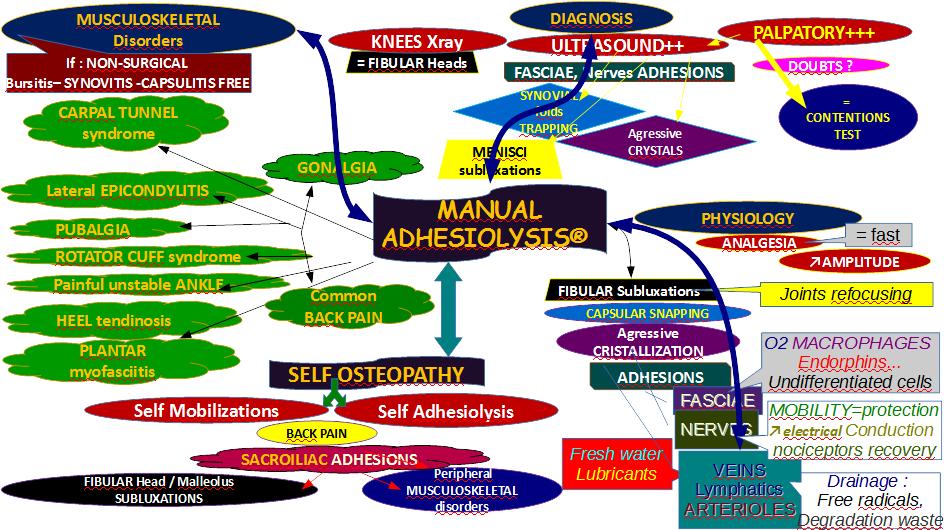Welcome to the Practice of Dr. Thierry Ho-Pun-Cheung
SOFMMO Award Winner (twice), Medal for Scientific and Technical Works from the Army Health Service
Innovative Manual Therapy for Restoring Mobility and Relieving Pain
- Understanding Fascia and Adhesions :
Did you know that fascia makes up about one-third of your body weight?
Fascia is essential connective tissue that supports your body’s functions—but when it becomes “stuck” (develops adhesions), it can lead to joint stiffness, poor proprioception, and chronic pain.
- Manual Adhesiolysis is a specialized technique that releases deep fascial adhesions to :
- Decompress joints, muscles, nerves, and blood vessels (especially lymphatic)
- Restore mobility and improve the overall function of your musculoskeletal and immune systems
- Rapid and Lasting Results :
When manual adhesiolysis is effective, improvements can be seen in as little as 72 hours.
For older patients, benefits may take a little longer to become noticeable due to underlying aches. If results are delayed, it is often due to your body’s natural healing process.
-
Clinical Benefits of Adhesiolysis :
- Immediate pain relief through increased range of motion, strength, and proprioception
- Improved nerve mobility and faster electrical conduction
- Better vascular decompression and lymphatic drainage
- Enhanced healing of tendons and ligaments
- Joint realignment (especially in the fibula and pelvis)
- Understanding Fascia (1/3 of body weight) and systematic adhesions:
Fascia are essential connective tissues for the body’s functioning (see pathophysiology). When they become “sticky” (adhesions), this leads to loss of joint range, proprioceptive disorders, and pain.
Manual adhesiolysis, by releasing deep adhesions, aims to: -
- Decompress joints, muscles, nerves, and vessels (especially lymphatic)
- Restore mobility and improve overall function of the musculoskeletal system (immune system, etc.)
- Training and Education
FIFPL-DPC Training Dates:
Montpellier: December 12–14, 2025
Strasbourg: December 5–7, 2025
Course Title: Manual Treatment of Fascia
Learn more: mkngformations.fr/therapies-manuelles/formation-adhesiolyse/
- Scientific Focus and Innovations :
Since 2006, dynamic ultrasound has confirmed the impact of fascial dysfunctions on muscle kinetics. Manual treatment, validated by echoscopic imaging, objectively normalizes mobility and optimizes the management of musculoskeletal disorders. - Main Treated Dysfunctions :
By correlating clinical benefits with imaging, we propose a physical diagnosis of these dysfunctions (normalization of which is essential for treating MSDs).- Adhesions, aggressive microcrystals
- Intra-articular entrapments
- Meniscal subluxations
- Subluxations of the Fibula Head (antero-superior > postero-superior > antero-inferior > postero-inferior)
- The 5 MAJOR ACTIONS of Deep Manual Adhesiolysis® :
- Detachment of inter-fascial adhesions: improves tissue gliding and joint centering
- Release of intra-articular folds: immediate relief
- Displacement (dissolution) of crystallizations: promotes tissue healing
- Normalization of fibula head subluxations: optimizes lower limb and pelvis function
- Recentering of the medial meniscus: avoids or delays knee surgery
- Complementary Manual Treatments :
- Normalization of the cervico-thoraco-lumbar posterior fascia
- Self-osteopathy® techniques essential for therapeutic education
Motivated patients who master Self-Osteopathy® (Self-Adhesiolysis + Self-Mobilizations + Self-Pumping) maintain long-term benefits.
- Multimedia Resources :
- Explanatory and demonstration videos on my YouTube channel
- Trailer for the film on the knee: diagnosis, treatments, self-manipulations
eBOOK + MOVIE on Manual Adhesiolysis® of knee pain illustrating our main discoveries: detailing anatomy, biomechanics, pathophysiology, diagnoses (especially tibio-fibular subluxations), imaging, treatments, and self-manipulations.
- MAIN INDICATIONS:
- Carpal Tunnel Syndrome (Dupuytren’s Disease / Trigger Finger)
- Lateral (Tennis Elbow) and Medial (Golf Elbow) Epicondylalgia
- Rotator Cuff Conflicts
- Painful Ankle Instability
- Heel Tendinopathies(Achilles, Calcaneal Tendinopathies), Periostitis, Plantar Myofasciitis
- Pubalgia
- Sacroiliac joints Dysfunctions (articular fibrosis starting in childhood).
- Non-surgical Back pain (manipulations controlled by echoscopy = in development).Note:
NB :For bursitis, synovitis (“glue factories”), or capsulitis (very thick fibrosis), several sessions will be needed.


- LIMITATIONS and Precautions: Manual Adhesiolysis is less effective in:
- Acute intervertebral disc wounds
- Inflammation of disc fissures colonized by nociceptors
= Gentle intervertebral “pumping” promotes disc vascularization and is more effective. This rehydration, via the vertebrae, occurs very slowly, explaining the long healing time. (See loss of intervertebral disc vascularization in adolescence.) - Inflammatory flare-up of posterior facet joints = avoid unnecessary painful joint mobilizations
NB: If pelvic “torsions” are predominant (>95% of adults), this is not necessarily our normal state (it is not certain that Homo sapiens has reached the peak of evolution for bipedalism). Moreover, Self-Osteopathy of the pelvis (practiced for life) maintains optimal sacroiliac mobility.
- The 4 Main Actions of Deep Manual Adhesiolysis®:
-
- By “detaching” inter-fascial adhesions:
- Tendino-muscular fascia glides better, relaxes, and joints recenter (= surfaces rub less)
- Nerve mobility between fasciae is restored, electrical conduction accelerates, and fascial nociceptors “rest”
- Vessels are decompressed:
- Arterioles = increased oxygenation, influx of neurotransmitters (endorphins), ATP, macrophages, undifferentiated cells, heat
- Veins and lymphatics = drainage of free radicals, degradation waste, etc.
- By releasing intra-articular entrapments of synovial folds: clinical improvement is immediate.
- By displacing irritant crystallizations in tendons, ligaments, or capsules, their lesions can begin to heal.
- By normalizing frequent subluxations of the fibula head (painless), the ankle and pelvis function better.
- Diagnosis (visual, palpatory…without imaging) of common knee pain causes (patellofemoral syndrome, tendinopathies…): deep fascial adhesions – capsular entrapments (vascular, nervous) – meniscal subluxations – fibula subluxations (essential, innovative, and therefore controversial);
- Treatments: fascial adhesions, capsular releases, etc.;
- Self-manipulations to empower patients; etc.
NB: When I write “films to be released,” understand: “if enthusiastic practitioners want to support me. And yes! At the end of my ‘career,’ I lose motivation to continue my research alone…”
More videos on my Youtube channel

